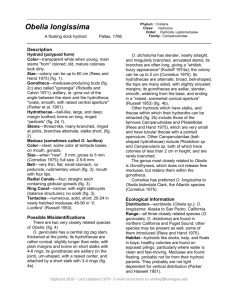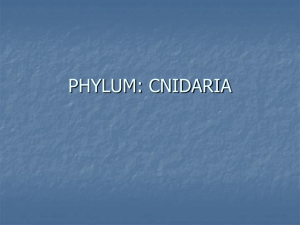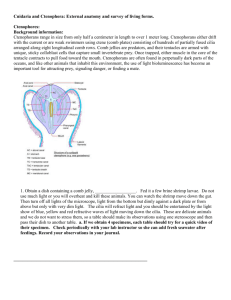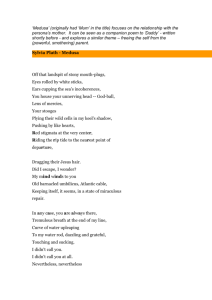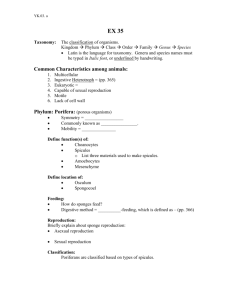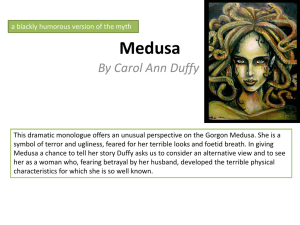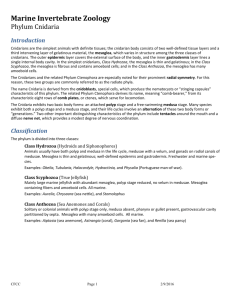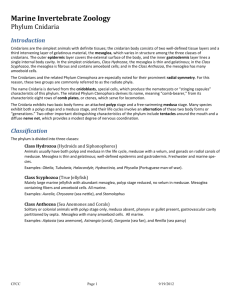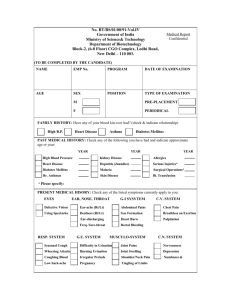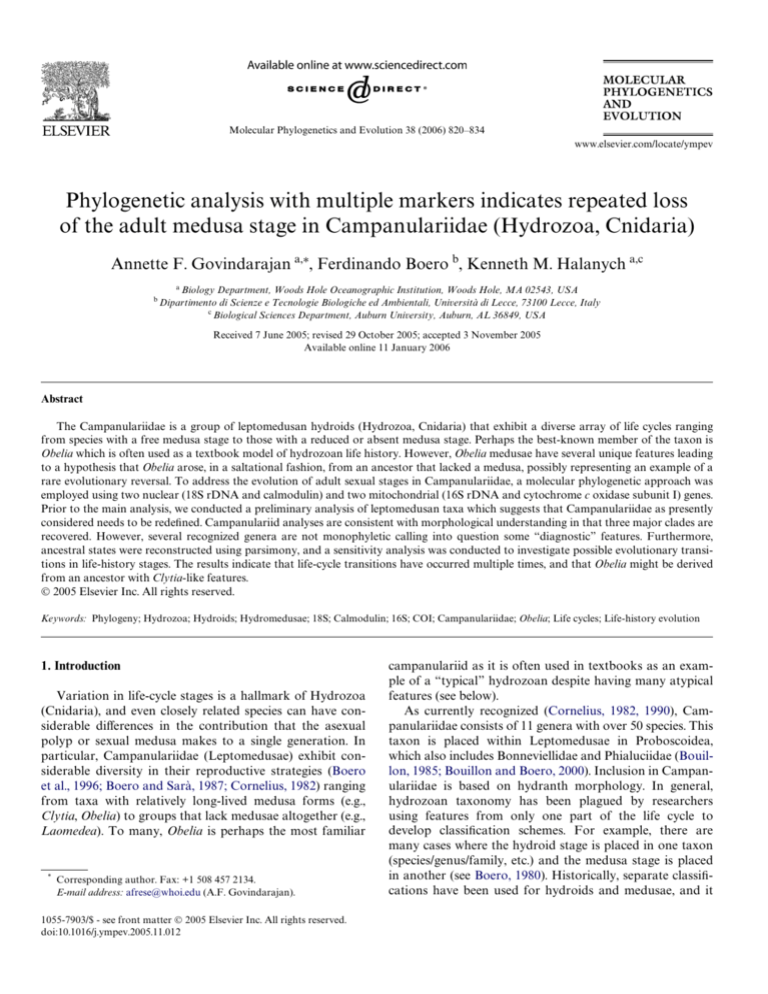
Molecular Phylogenetics and Evolution 38 (2006) 820–834
www.elsevier.com/locate/ympev
Phylogenetic analysis with multiple markers indicates repeated loss
of the adult medusa stage in Campanulariidae (Hydrozoa, Cnidaria)
Annette F. Govindarajan a,¤, Ferdinando Boero b, Kenneth M. Halanych a,c
a
b
Biology Department, Woods Hole Oceanographic Institution, Woods Hole, MA 02543, USA
Dipartimento di Scienze e Tecnologie Biologiche ed Ambientali, Università di Lecce, 73100 Lecce, Italy
c
Biological Sciences Department, Auburn University, Auburn, AL 36849, USA
Received 7 June 2005; revised 29 October 2005; accepted 3 November 2005
Available online 11 January 2006
Abstract
The Campanulariidae is a group of leptomedusan hydroids (Hydrozoa, Cnidaria) that exhibit a diverse array of life cycles ranging
from species with a free medusa stage to those with a reduced or absent medusa stage. Perhaps the best-known member of the taxon is
Obelia which is often used as a textbook model of hydrozoan life history. However, Obelia medusae have several unique features leading
to a hypothesis that Obelia arose, in a saltational fashion, from an ancestor that lacked a medusa, possibly representing an example of a
rare evolutionary reversal. To address the evolution of adult sexual stages in Campanulariidae, a molecular phylogenetic approach was
employed using two nuclear (18S rDNA and calmodulin) and two mitochondrial (16S rDNA and cytochrome c oxidase subunit I) genes.
Prior to the main analysis, we conducted a preliminary analysis of leptomedusan taxa which suggests that Campanulariidae as presently
considered needs to be redeWned. Campanulariid analyses are consistent with morphological understanding in that three major clades are
recovered. However, several recognized genera are not monophyletic calling into question some “diagnostic” features. Furthermore,
ancestral states were reconstructed using parsimony, and a sensitivity analysis was conducted to investigate possible evolutionary transitions in life-history stages. The results indicate that life-cycle transitions have occurred multiple times, and that Obelia might be derived
from an ancestor with Clytia-like features.
2005 Elsevier Inc. All rights reserved.
Keywords: Phylogeny; Hydrozoa; Hydroids; Hydromedusae; 18S; Calmodulin; 16S; COI; Campanulariidae; Obelia; Life cycles; Life-history evolution
1. Introduction
Variation in life-cycle stages is a hallmark of Hydrozoa
(Cnidaria), and even closely related species can have considerable diVerences in the contribution that the asexual
polyp or sexual medusa makes to a single generation. In
particular, Campanulariidae (Leptomedusae) exhibit considerable diversity in their reproductive strategies (Boero
et al., 1996; Boero and Sarà, 1987; Cornelius, 1982) ranging
from taxa with relatively long-lived medusa forms (e.g.,
Clytia, Obelia) to groups that lack medusae altogether (e.g.,
Laomedea). To many, Obelia is perhaps the most familiar
*
Corresponding author. Fax: +1 508 457 2134.
E-mail address: afrese@whoi.edu (A.F. Govindarajan).
1055-7903/$ - see front matter 2005 Elsevier Inc. All rights reserved.
doi:10.1016/j.ympev.2005.11.012
campanulariid as it is often used in textbooks as an example of a “typical” hydrozoan despite having many atypical
features (see below).
As currently recognized (Cornelius, 1982, 1990), Campanulariidae consists of 11 genera with over 50 species. This
taxon is placed within Leptomedusae in Proboscoidea,
which also includes Bonneviellidae and Phialuciidae (Bouillon, 1985; Bouillon and Boero, 2000). Inclusion in Campanulariidae is based on hydranth morphology. In general,
hydrozoan taxonomy has been plagued by researchers
using features from only one part of the life cycle to
develop classiWcation schemes. For example, there are
many cases where the hydroid stage is placed in one taxon
(species/genus/family, etc.) and the medusa stage is placed
in another (see Boero, 1980). Historically, separate classiWcations have been used for hydroids and medusae, and it
A.F. Govindarajan et al. / Molecular Phylogenetics and Evolution 38 (2006) 820–834
was not until Naumov (1960) that the Wrst uniWed classiWcation was proposed. The apparent diVerence in rates of
morphological evolution occurring in hydroids and medusae (Morton, 1957; Naumov, 1960; Rees, 1957) has further
complicated matters. Researchers (e.g., Allman, 1864;
Boero and Sarà, 1987; Cornelius, 1982; Millard, 1975; Rees,
1957; Vervoort and Watson, 2003) explicitly or implicitly
assuming that losses or reductions of the medusa stage are
rare have used life-cycle type to deWne genera. Others (e.g.,
Boero et al., 1996; Broch, 1916; Cunningham and Buss,
1993; Kramp, 1949; Petersen, 1979, 1990) have speculated
that medusa loss happens relatively frequently, questioning
whether current taxonomy accurately reXects phylogeny.
The range of complex life cycles, the frequency of medusa
loss (e.g., Petersen, 1990), and the possibility of “reinvented” medusae (e.g., Boero and Sarà, 1987) have fueled
controversy on hydrozoan life-cycle evolution and
systematics.
In campanulariids, the variation in the sexual adult portion of the life cycle is notable and has been used to delineate recognized genera (Table 1, Cornelius, 1982). The
structure producing sexual adults is referred to as the gonophore, and in campanulariids there are four main types:
Wxed gonophores, meconidia, medusoids, and medusae. The
three leading hypotheses of campanulariid phylogeny are
depicted in Fig. 1. DiVerences in these hypotheses are based
largely on concepts of gonophore evolution within Obeliinae (Obelia, Laomedea, Gonothyraea, and Hartlaubella).
Cornelius (1982) hypothesized a progression from medusae
to medusoids/meconidia to Wxed gonophores (Fig. 1A).
Östman (1987; Fig. 1B) suggested Gonothyraea was the
basal obeliniid, based on the presence of a type of nematocyst also found in other campanulariids but not Obelia.
This hypothesis built on the work of Boero and Sarà (1987)
that the Obelia medusa was secondarily derived. Boero
821
et al. (1996; Fig. 1C), in contrast, placed Wxed gonophore
Laomedea as the basal obeliniid.
Much of the debate between these hypotheses centers on
the nature of the Obelia medusa. Obelia medusae have morphological and developmental features that are unusual
among the Hydrozoa (Boero et al., 1996; Chapman, 1968;
Kühn, 1913). These features include anatomy of solid tentacles, shape of the manubrium (i.e., mouth), absence of a
velum, statocyst position, absence of tentacular bulbs, position of developing gonads, and myoWbril arrangement in the
medusa bell. Some of these features (e.g., tentacles and manubrium) are more hydroid-like than medusa-like. Obelia
medusa development also diVers from all other hydrozoan
medusae, in that the entocodon (a proliferation of ectoderm
along the blastostyle that leads to the subumbrellar cavity)
seems to disappear early in development (Boero et al., 1996;
Kühn, 1913). Interestingly, another campanulariid, Gonothyraea, produces a sexual structure termed meconidia, that
shares some “medusa” features with Obelia (e.g., solid tentacles; Boero et al., 1996). Because of their combination of original, medusa-like, and hydranth-like properties, Boero et al.
(1996) suggest the possibility that Obelia medusae may have
arisen via detaching hydranths that become sexually mature.
Detachable hydranths are found in Zeulonies estrambordi, a
species that appears to have campanulariid aYnities (Boero
et al., 1996; Gravier-Bonnet, 1992).
Campanulariid phylogenetic relationships and the evolution of their sexual stages have never been examined using an
explicit phylogenetic reconstruction algorithm. Here, we have
used data from nuclear (18S rDNA and calmodulin) and
mitochondrial (16S rDNA and cytochrome c oxidase subunit
I [COI]) markers in parsimony, maximum likelihood, and
Bayesian analyses to reconstruct the group’s evolutionary history. To address hypotheses of the sexual medusa stage, we
use parsimony to reconstruct ancestral character states on the
Table 1
Campanulariid subfamilies and genera and their associated sexual stage (gonophore type)
Subfamily
Genus
Gonophore type
Description
Campanulariinae
Orthopyxis
Medusoids
Silicularia
Medusoids
Campanularia
Rhizocaulusa
Tulpa
Billardiac
Fixed gonophores
Fixed gonophores
Fixed gonophores
Fixed gonophores
With some medusa features (i.e., radial canals) but not others (i.e., tentacles),
some with extracapsular development (acrocysts); may or may not be released
from the hydroid
With some medusa features (i.e., radial canals) but not others; not known to be
released from the hydroid
Gonophores with no medusa features; Wxed on the hydroid
Gonophores with no medusa features; Wxed on the hydroid
Gonophores with no medusa features; Wxed on the hydroid
Gonophores with no medusa features; Wxed on the hydroid
Clytiinae
Clytiab
Medusae
Typical hydrozoan medusae
Obeliinae
Obelia
Gonothyraeaa
Medusae
Meconidia
Hartlaubellaa
Laomedea
Fixed gonophores
Fixed gonophores
Atypical hydrozoan medusae
With some medusa features (i.e., tentacles), but not others; medusa features
similar to Obelia, rather than typical, medusae; not released from the hydroid
Gonophores with no medusa features; Wxed on the hydroid
Gonophores with no medusa features; some with extracapsular development
(acrocysts); Wxed on the hydroid
a
b
c
Considered by Cornelius (1982) to be monotypic genus.
Including Gastroblasta.
Billardia is considered by some (e.g., Ralph, 1957; Vervoort and Watson, 2003) to be a campanulariid but not Cornelius (1982).
822
A.F. Govindarajan et al. / Molecular Phylogenetics and Evolution 38 (2006) 820–834
Fig. 1. Proposed relationships among the Campanulariidae, reXecting three possibilities for the evolution of Obelia. Note, the Obeliinae lineage (highlighted in bold) consists of Obelia, Gonothyraea, Laomedea, and Hartlaubella. (A) Obelia derived from typical medusae (Cornelius, 1982); (B) Obelia
derived from Wxed gonophores, which was derived from meconidia (Östman, 1987); (C) Obelia derived from Wxed gonophores (Boero et al., 1996). Cornelius (1982) and Boero et al. (1996) considered Silicularia to have Wxed gonophores. However, they have medusoids (Blanco, 1967; Ralph, 1956) and their
Wgures are modiWed here. All hypotheses show a single loss of medusae in the Campanulariinae and Obeliinae lineages. Finally, Boero et al. consider Clytia
to be part of the Obeliinae rather than a separate lineage as in Cornelius (1982) and Östman (1987).
resultant topology. Determining if the Obelia medusa was secondarily derived from ancestors without medusa and whether
medusa loss was a rare event were of particular interest. Other
studies (e.g., Emlet, 1995; Hart et al., 1997; Wray, 1996) of lifecycle evolution usually consider benthic adults and planktonic
larvae whereas, in the present study, we consider the adult,
sexually competent medusa, and not the planula larva, as the
main planktonic stage in the hydrozoan life cycle.
2. Materials and methods
2.1. Sample collection and outgroup selection
Field-collected hydroids were identiWed by taxonomic
experts (F. Boero, D. Calder, A. Govindarajan, C. Gravili,
A. Lindner, S. Piraino, and P. Schuchert). Samples were
split into morphological vouchers (10% formalin) and
DNA samples (95% non-denatured ethanol). Taxa
employed in this study, collection localities, and GenBank
accession numbers are listed in Table 2. Morphological
vouchers for most specimens were deposited in the Smithsonian Museum of Natural History invertebrate collections. Forty-seven of these operational taxonomic units
(OTUs) are putative campanulariids with all recognized
genera except Hartlaubella and Tulpa represented. Due to
the potential existence of cryptic species, multiple representatives from diVerent locations of some nominal species
were included when available. Because relationships within
Leptomedusae have not been well established, several
thecate hydroids were used as outgroups (Table 2).
A.F. Govindarajan et al. / Molecular Phylogenetics and Evolution 38 (2006) 820–834
823
Table 2
Campanulariid taxa and outgroups used in this study, collection locality, genes sequenced, and GenBank accession numbers
Campanulariidae
Taxon
Locality
18S rDNA
Campanulariinae
Billardia subrufaa,b
Campanularia hincksiia
Campanularia volubilisa
Orthopyxis evertaa
Orthopyxis integraa
Orthopyxis integraa
Orthopyxis integra CA sp. 1a
Orthopyxis integra CA sp. 2a
Orthopyxis integraa
Orthopyxis integra
Orthopyxis integraa
Orthopyxis sargassicola
Rhizocaulus verticillatusa
Silicularia roseaa
Antarctic peninsula
Otranto, Italy
Monterey, CA, USA
Torre del Serpe, Italy
Italy
Friday Harbor, WA, USA
Monterey, CA, USA
Monterey, CA, USA
Aleutians, USA
Sandgerdi, Iceland
New Zealand
Brazil
Aleutians, USA
Bay of Islands, New Zealand
AY789779
AY789729
AY789739
AY789728
AY789734
AY789733
AY789731
AY789732
AY789735
AY789737
AY789736
AY789730
AY789738
AY789727
Clytia elsaeoswaldae
Clytia gracilisa
Clytia gracilis
Clytia gracilisa
Clytia gracilis
Clytia hemisphaericaa
Clytia hummelinckia
Clytia hummelincki
Clytia linearis
Clytia linearisa
Clytia linearis
Clytia noliformis
Clytia paulensisa
Clytia sp.
Brazil
Georges Bank, North Atlantic
Italy
Beaufort, NC, USA
Woods Hole, MA, USA
North Sea
S. Caterina, Italy
South Africa
Brazil
Torre Inserraglio, Italy
Beaufort, NC, USA
Brazil
Otranto, Italy
CA, USA
Gonothyraea lovenia
Gonothyraea loveni
Laomedea calceoliferaa
Laomedea Xexuosa
Laomedea Xexuosaa
Laomedea Xexuosaa
Laomedea inornataa
Obelia bidentataa
Obelia bidentataa
Obelia dichotomaa
Obelia geniculata
Obelia geniculataa
Obelia geniculataa
Obelia geniculataa
Obelia longissimaa
Obelia longissimaa
Obelia longissima
Obelia longissimaa
Obelia longissimaa
Aequorea aequorea
Aequorea victoria
Gymnangium hians
Blackfordia virginica
Bonneviella regiaa
Bonneviella sp. 2a
Bonneviella sp. 3
Bonneviella sp. 4a
Calycella syringaa
Stegella lobataa
Eugymnanthea inquilina
Eucheilota bakeria
Chlorohydra viridissima
Clytiinae
Obeliinae
Outgroups
Aequoreidae
Aequoreidae
Aglaopheniidae
Blackfordiidae
Bonneviellidae
Bonneviellidae
Bonneviellidae
Bonneviellidae
Campanulinidae
Campanulinidae
Eirenidae
Eucheilotidae
Hydridae
Calmodulin
16S rDNA
COI
AY789837
AY789845
AY789882
AY789889
AY789881
AY789884
AY789843
AY789838
AY789844
AY789836
AY789794
AY789804
AY789793
AY789799
AY789798
AY789796
AY789797
AY789800
AY789802
AY789801
AY789795
AY789803
AY789792
DQ064796
AY789750
AY789749
AY789752
AY789751
AY789753
AY789745
AY789744
DQ064794
AY789747
AY789748
DQ064795
AY789746
AF358074
DQ064799
AY789855
AY789854
AY789857
AY789856
AY789858
AY789851
AY789850
DQ064797
AY800196
AY789853
DQ064798
AY789852
AY800197
DQ064793
AY789811
AY346364
AY789813
AY789812
AY789814
AY326363
AY789809
DQ064791
AY346362
AY789810
DQ064792
AY346361
AY800195
Dennis, MA, USA
RoscoV, France
Woods Hole, MA, USA
RoscoV, France
Iceland
White Sea
Friday Harbor, WA, USA
Beaufort, NC, USA
North Sea
Otranto, Italy
RoscoV, France
New Brunswick, Canada
Japan
New Zealand
Ryders Cove, MA, USA
Antarctic peninsula
Dunedin, New Zealand
Sandgerdi, Iceland
White Sea
AY789765
AY789766
AY789768
AY789762
AY789763
AY789764
AY789761
AY789754
AY789755
AY789767
AY789769
AY789770
AY789771
AY789772
AY789757
AY789760
AY789756
AY789759
AY789758
AY789869
AY789870
AY789872
AY789866
AY789867
AY789868
AY789865
AY789859
AY789860
AY789871
AY789873
AY789874
AY789875
AY789876
AY789864
AY789861
AY789863
AY789862
AY789826
AY789827
AY789829
AY789823
AY789824
AY789825
AY789822
AY789815
AY789816
AY789828
AY530359
AY530344
AY530335
AY530378
AY789818
AY789821
AY789817
AY789820
AY789819
GenBank
GenBank
GenBank
GenBank
Aleutians, USA
Aleutians, USA
Aleutians, USA
Aleutians, USA
Woods Hole, MA, USA
Antarctic peninsula
Taranto, Italy
CA, USA
GenBank
AF358076
AF358077
Z86122
AF358078
AY789740
AY789741
AY789742
AY789743
AY789776
AY789778
AY789775
AY789774
AF358081
AY789846
AY789847
AY789848
AY789849
AY789879
AY789805
AY789806
AY789807
AY789808
AY789833
AY789890
AY789891
AY789892
AY789893
AY789916
AY789878
AY789877
AY789832
AY789831
AY789915
AY789841
AY789840
AY789839
AY789842
AY789885
AY789887
AY789886
AY789883
AY789888
DQ064800
AY789899
AY789898
AY789901
AY789900
AY789902
AY789895
AY789894
AY789897
AY789896
AY789903
AY789914
AY789910
AY789911
AY789912
AY789904
AY789905
AY789913
AY530410
AY530395
AY530386
AY530429
AY789909
AY789906
AY789908
AY789907
(continued on next page)
824
A.F. Govindarajan et al. / Molecular Phylogenetics and Evolution 38 (2006) 820–834
Table 2 (continued)
Campanulariidae
Taxon
Locality
18S rDNA
Hydridae
Laodiceidae
Lovenellidae
Phiallelidae
Sertulariidae
Tiaropsidae
Hydra circumcincta
Melicertissa sp.
Lovenella gracilisa
Opercularella pumilaa
Selaginopsis cornigera
Tiaropsidium kelseyi
GenBank
GenBank
Wildwood Crest, New Jersey
Woods Hole, MA, USA
GenBank
GenBank
AF358080
AF358075
AY789773
AY789777
Z92899
AF358079
a
b
Calmodulin
16S rDNA
AY789880
AY789830
AY789834
COI
Voucher specimen deposited at the Smithsonian Museum.
Billardia is considered by some (e.g., Ralph, 1957; Vervoort and Watson, 2003) to be a campanulariid but not by Cornelius (1982).
We conducted a preliminary analysis of 18S leptomedusan
data to determine the sister lineages and inclusiveness of
Campanulariidae. Two species of Hydridae (Collins, 2000,
2002) were used to root the Leptomedusae analysis.
biguous. All alignments have been deposited in TREEBASE (www.treebase.org).
2.2. Data collection
In addition to the leptomedusan 18S alignment, a master
alignment of all four genes was produced for campanulariids. In this combined dataset, 18S and 16S were available
for all OTUs, but fragments for calmodulin and CO1 were
not available for some taxa and those data were coded as
missing. Parsimony (PARS), maximum likelihood (ML),
and Bayesian inference (BI) analyses were conducted for
each gene fragment individually and with the all genes combined. We emphasize our results obtained with likelihoodbased methods because of known problems of parsimony
with rate variation.
PAUP* 4.0b10 (SwoVord, 2002) was used for maximum
likelihood and parsimony analysis. The best-Wt models for
maximum-likelihood analysis were determined with ModelTest using the hierarchical likelihood ratio tests Posada and
Crandall, 1998). Heuristic searches were conducted using
starting trees obtained by stepwise addition with 10 random
addition sequence replicates and tree bisection–reconnection
(TBR) branch swapping. Nodal support was obtained from
non-parametric bootstrap analyses. For parsimony, 1000
bootstrap replicates were run with the maximum number of
trees saved in each bootstrap replicate set to 1000 (100 per
addition sequence replicate). Due to computational limitations, likelihood bootstrap analyses consisted of 100 replicates using one addition sequence replicate and limiting the
number of rearrangements to 5000. Bayesian posterior probabilities were calculated with MRBAYES 3.0b4 (Ronquist
and Huelsenbeck, 2003). Bayesian analyses were run for
1,000,000 generations with four chains and a sample frequency of 1000. Burn-in was set at 200, and a plot of log likelihoods versus generation was examined to conWrm that the
likelihood values had leveled oV. MrBayes was used to calculate the model parameters after we assumed a general
GTR + + I model. Bayesian posterior probabilities may
sometimes overestimate support (Erixon et al., 2003; Simmons et al., 2004), and thus for the purpose of discussion,
only nodes with high bootstrap values and post. prob. were
considered well supported. Topological hypotheses were
tested with the Shimodaira–Hasegawa (SH) test (Shimodaira
and Hasegawa, 1999) implemented in PAUP* 4.0b10 using
the RELL test distribution.
DNA was extracted using DNEasy extraction kits
(Qiagen) following the manufacturer’s protocol. The entire
18S rDNA and portions of calmodulin, 16S rDNA, and COI
were ampliWed using procedures and primers described in
Halanych et al. (1998) for 18S rDNA, Lindner, 2005 for calmodulin, Cunningham and Buss (1993) for 16S rDNA, and
Folmer et al. (1994) for COI. PCR products were visualized
on a 1% agarose gel stained with ethidium bromide. In most
cases, the target region was ampliWed in one reaction; however, in a few cases, the 18S rDNA gene was ampliWed in
three overlapping segments. A few PCR products for calmodulin were re-ampliWed in order to obtain suYcient quantities for direct sequencing.
Overlapping 18S rDNA, calmodulin, 16S rDNA, and COI
products were puriWed directly from PCR products using the
Qiagen PCR puriWcation kit according to manufacturer’s
protocol. In the case of full-length 18S rDNA, products were
size selected on agarose gels (due to the occasional presence
of multiple products) and puriWed using the Qiagen PCR gel
puriWcation kit. Some 18S fragments were cloned using the
Promega T-GEM easy kit and colonies were screened by
PCR ampliWcation. The Promega Wizard miniprep kit was
used following manufacturer’s protocol.
After unincorporated dideoxynucleotides were removed
with a Sephadex G-25 (Sigma) column, all templates were
bi-directionally cycle-sequenced using either Big Dye 2 or 3
sequencing chemistry (ABI), as recommended, using an
ABI 377 or 3700 automated DNA sequencer. For all gene
fragments, ampliWcation primers were used for sequencing.
Additionally, the standard primers m13F and m13R, as
well as six internal primers (Halanych et al., 1998) were
used for the 18S fragment as appropriate. DNA sequences
were checked using Autoassembler (ABI) and Sequencher
4.2.2 (Genecodes).
Sequences were aligned using ClustalX (Thompson
et al., 1994) and conWrmed by eye using MacClade (Maddison and Maddison, 2000). Regions that could not be unambiguously aligned from the rDNA were excluded from
analyses. Alignments of calmodulin and COI were unam-
2.3. Phylogenetic analysis
A.F. Govindarajan et al. / Molecular Phylogenetics and Evolution 38 (2006) 820–834
825
Table 3
Maximum-likelihood model parameters
Data sets
Maximum likelihood
Model
Base frequencies
A
C
G
Substitution rates
T
AMC
AMG
Leptomedusae
18S (38 taxa) TrN + I + G 0.2756 0.1885 0.2684 0.2675 1.0000
Campanulariidae
Combined
GTR + I + G
(55 taxa)
18S (55 taxa) TIM + I + G
Calmodulin TrN + I + G
(50 taxa)
16S (55 taxa) GTR + I + G
COI (41 taxa) GTR + I + G
AMT
CMG CMT
Shape
Proportion
parameter of invariant
GMT
sites
3.0829
1.0000 1.0000
7.0861 1.0000 0.7003
0.5234
0.3030 0.1646 0.2274 0.3051 3.4181
14.0885
10.4813 2.8637
43.5166 1.0000 0.4865
0.5886
0.2753 0.1897 0.2651 0.2699 1.0000
0.4200 0.1567 0.1616 0.2617 1.0000
4.2396
5.4449
1.8041 1.8041
1.0000 1.0000
9.3501 1.0000 0.6296
14.8099 1.0000 0.7832
0.5823
0.5910
0.4502 0.0942 0.1065 0.3490 130537.5078 722000.8750 92989.7578 0.0001 1258584.5000 1.0000 0.2875
0.3382 0.1081 0.1401 0.4135
7.1057
23.7533
12.4729 4.9198
180.0143 1.0000 0.7624
0.5462
0.5391
In order to understand the evolution of medusa form
(i.e., gonophore evolution), OTUs were scored as having
Wxed gonophores, meconidia, medusoids, typical medusae,
or Obelia medusae. Gonophore type was mapped on to the
resultant phylogeny based on the combined dataset (see
below), and the ancestral states were reconstructed using
parsimony criteria in MacClade 4.0 (Maddison and Maddison, 2000). Based on Boero et al. (1996), the last common
ancestral campanulariid was assumed to have a typical
medusa stage. In particular, Clytia medusae bear striking
morphological resemblance to other leptomedusa (e.g.,
Phialella) suggesting it is pleisomorphic for campanulariids.
We implemented this assumption by using a single outgroup scored as possessing a typical medusa. The loss of a
complex morphological character has been considered to
be more common than a gain. Furthermore, frequent losses
may bias inference of ancestral character states (Cunningham, 1999; Cunningham et al., 1998). Applying this logic to
campanulariids, going from medusae to medusoids or Wxed
gonophores (i.e., a loss) may be easier than going from Wxed
gonophores and medusoids to medusae (i.e., a gain). In
order to explore the robustness of conclusions on ancestral
character states, a sensitivity analysis was conducted using
diVerential weighting of gains as more costly than losses
(e.g., Omland, 1997; Ree and Donoghue, 1998). Gain costs
(weights) were tested at 0.1 increments between 1 and 2, and
then periodically (3, 10, 25, 50, and 75) up to 99.
nucleotide positions that could be unambiguously aligned,
27.2% (434 positions) were variable and 16.0% (255 positions) were parsimony informative. Fig. 2 shows the best
ML tree (¡ln likelihood D 7442.80525) reconstructed using
the parameters indicated on Table 3.
The Campanulariidae (highlighted in Fig. 2) is not
monophyletic as traditionally recognized because taxa not
traditionally considered campanulariids fall within the
clade. Bonneviella (Bonneviellidae) were strongly supported
(PARS D 95%; ML D 100%; post. prob. D 1.00) to be deeply
nested within Campanulariinae forming a clade with Campanularia
volubilis
and
Rhizocaulus
verticillatus
(PARS D 90%; ML D 85%; post. prob. D 1.00). Lovenella
gracilis (Lovenellidae) and Eucheilota bakeri (Eucheilotidae) are very similar genetically and constitute a weakly
supported (PARS D <50%; ML D 67%; post. prob. D 1.00)
clade within Campanulariidae. Additionally, Billardia subrufa fell outside the main “campanulariid” clade (bootstrap
PARS and ML D 100%, posterior probabilities D 1.00, and
SH test p D 0.000; Table 4). This result is contra Ralph
(1957) and Vervoort and Watson (2003) and consistent
with its placement in another family such as the Lafoeidae
or Syntheciidae (Cornelius, 1982; Millard, 1975).
Based on results of this preliminary analysis, representatives of the sister clade to Campanulariidae and the next
basal most lineage were chosen as outgroups subject to
availability of tissue for data collection from additional
markers. These taxa included Calycella syringa (Campanulinidae), Opercularella pumila (Phialellidae), and Eugymnanthea inquilina (Eirenidae). Note that Campanulinidae is
not monophyletic as Stegella lobata falls in a basal
leptomedusan clade with B. subrufa and Melicertissa sp.
(Laodiceidae).
3. Results
3.2. Relationships in Campanulariidae
3.1. Identifying outgroups and delineating Campanulariidae
Taxa incorporated into the phylogenetic analysis of
Campanulariidae were adjusted to include L. gracilis,
E. bakeri, and bonneviellid taxa. B. subrufa was not
included. The data were analyzed both together (Fig. 3) and
For both ML and BI, substitution models were estimated for each dataset individually as well as the combined
dataset (Table 3).
2.4. Ancestral character reconstruction
The 18S rDNA alignment for the leptomedusan analysis
included 38 OTUs and 2057 base pairs (bp). Of the 1595
826
A.F. Govindarajan et al. / Molecular Phylogenetics and Evolution 38 (2006) 820–834
Fig. 2. Maximum-likelihood tree of the leptomedusan data set. Putative campanulariids are indicated in bold and a solid black circle is on the node deWning the Campanulariidae as deWned for subsequent analyses. The reconstructed topology is from a heuristic search based on 18S rDNA. The ¡ln likelihood for the topology D 7442.80525. First number along the branches refers to maximum-likelihood bootstrap values, second number refers to parsimony
bootstrap values, and third number refers to Bayesian posterior probability values. Location codes for some OTUs (see Table 2): AN, Antarctic peninsula;
AS, Aleutians; BR, Brazil; CA, California; FR, France; GB, Georges Bank; IC, Iceland; IT, Italy; JP, Japan; MA, Massachusetts; NB, New Brunswick;
NJ, New Jersey; NZ, New Zealand; NC, North Carolina; NS, North Sea; SA, South Africa; WA, Washington.
separately (Figs. 4 and 5). Most phylogenetic signal came
from 18S rDNA data, whereas other markers were generally very poorly resolved. Therefore, the combined and 18S
rDNA (which allowed for increased taxon sampling) results
are emphasized below due to space considerations. Combined and 18S analyses yielded similar results, with a few
exceptions as noted. PARS, ML, and BI support usually
agreed, although in some cases Bayesian posterior probabilities were considerably higher than likelihood and parsimony bootstrap values. Individually calmodulin, 16S nor
CO1 placed all outgroups outside of campanulariids, but
this result was never well supported (Fig. 5).
The combined alignment included 38 OTUs (three as
outgroups) and 3546 bp. Of the 3108 bp (18S: 1612 bp;
CAM: 401 bp; 16S: 434 bp; and COI: 661 bp) that could be
unambiguously aligned, 28.6% (total: 890 positions; 18S:
359; CAM: 125; 16S: 131; and COI: 275) were variable and
21.7% (total: 673 positions; 18S: 216; CAM: 107; 16S: 105;
and COI: 245) were parsimony informative when third
positions were included. In the two protein-coding genes,
most of the variation occurred in third codon positions
(110/125 variable sites in CAM and 208/275 in COI). Fig. 3
shows the best ML tree (¡ln likelihood D 20426.3370)
reconstructed (model parameters in Table 3).
A.F. Govindarajan et al. / Molecular Phylogenetics and Evolution 38 (2006) 820–834
827
Table 4
Results of Shimodaira–Hasegawa tests for monophyly of recognized families and genera
Constraint
Monophyly tested
Family 1
Campanulariidae, as deWned with Billardia, the bonneviellids,
and Eucheilota and Lovenella
Campanulariidae, as deWned without Billardia, the bonneviellids,
and Eucheilota and Lovenella
Campanulariidae, as deWned without Billardia, and Eucheilota and
Lovenella, but with the bonneviellids
Campanulariidae, as deWned with Eucheilota and Lovenella, and without
Billardia and the bonneviellids
Obelia + Laomedea +Gonothyraea
Obelia
Laomedea
Campanularia + Rhizocaulus + Bonneviella (Campanulariinae with
Wxed gonophores)
Family 2
Family 3
Family 4
Obeliinae
Obelia
Laomedea
Campanularia
¡ln L best
DiV ¡ln L
p value
7442.80525
¡ln L constraint
7547.97789
105.17264
0.000
7442.80525
7514.35024
71.54499
0.001
7442.80525
7446.50419
3.69894
0.255
7442.80525
7485.02453
42.21928
0.009
20426.69624
20426.69624
20426.69624
20426.69624
20426.85739
20767.61421
20746.78747
20431.36449
0.16110
340.91797
320.09123
4.66825
0.483
0.000
0.000
0.294
The best tree (unconstrained) was compared with the best tree under the given constraints.
The combined analysis reveals considerable resolution in
the campanulariid tree except near the base of the Obeliinae/Clytiinae clade (see below). In comparison to the preliminary 18S analysis, E. bakeri and L. gracilis appear basal
to Campanulariidae, although this placement is not signiWcantly supported by bootstrap or post. prob. The recognized “subfamilies” (Table 1) appear well resolved with
some modiWcation. The Campanulariinae is strongly supported
(Fig. 3—PARS D 100%;
ML D 100%;
post.
prob. D 1.00) including a Bonneviella clade as sister to R.
verticillatus. The Clytiinae are monophyletic, and even
though the basal most node (including Clytia hummelincki)
is not well supported, the remainder of the clade is moderately supported (PARS D 96%; ML D 80%; post.
prob. D 1.00). The Obeliinae as described in Table 1 forms
three clades each with strong support (PARS D 100%;
ML D 100%; post. prob. D 1.00), but the Obelia bidentata
clade clusters with Clytiinae rather than Obeliinae in the
combined ML tree. Analyses of individual datasets are variable concerning placement of O. bidentata. However, both
PARS and BI weakly support (values of 72 and 0.60,
respectively) the placement of O. bidentata in Obeliinae, as
the basal member of the clade containing Laomedea Xexuosa, Laomedea inornata, and Obelia longissima (this
arrangement not depicted in Fig. 3). The 18S rDNA only
analysis is consistent with this position but only PARS
Wnds strong support (bootstrap D 95%). A heuristic ML
analysis of the combined dataset with O. bidentata removed
yields a topology otherwise identical to Fig. 3. Interestingly,
the placement observed in the combined data set appears to
be coming from CO1 data or possibly calmodulin (Fig. 5).
One other taxon that deserves mention is Campanularia,
which is not monophyletic in either Fig. 3 or Fig. 4. In the
combined analysis, Orthopyxis everta and Orthopyxis integra Italy (IT) group together strongly (Fig. 3, see also
Fig. 5), while in the 18S rDNA analysis, Or. everta and
Campanularia hincksii group together strongly. All three of
the above taxa were collected in Italy, but were obtained
and processed at diVerent times so contamination appears
unlikely.
In the combined analysis, three recognized campanulariid genera (Campanularia, Obelia, and Laomedea) and
two species (Or. integra and Clytia gracilis) appear not to
be monophyletic. In all of these cases, strong support is
found for at least one node preventing monophyly. SH tests
also signiWcantly reject (both p < 0.001) monophyly of Obelia and Laomedea. Non-monophyly of these taxa is also
supported by 18S only analyses.
3.3. Ancestral character reconstruction
The topology used for ancestral state reconstructions
(Fig. 6) was derived from the analysis of the combined data.
However, we choose to employ the PAR and BI topology
because O. bidentata is placed with other obeliinids rather
than clytiinids, an interpretation more consistent with morphology (Obelia medusae are morphologically indistinguishable). This topology is not signiWcantly less likely than
the most likely topology (Table 4, p D 0.483).
As expected based on the phylogenetic Wndings above,
at least some campanulariid life cycles exhibit parallelism
or convergence. SpeciWcally, we must consider one of the
following: Wxed gonophores evolved multiple times, de
novo Obelia-type medusa have evolved multiple times, or
that the expression of the Obelia medusa has been turned
on/oV several times. Note that in the last case the medusa
would be homologous across taxa but suppression could
be due to a number of diVerent non-homologous genetic
changes (i.e., there may be numerous ways to turn oV regulatory genes controlling medusa development). When
gains and losses were equally weighted unequivocal character states could not be assigned from the campanulariid
basal node up to several basal lineages within Obeliinae.
However, as soon as gains were weighted slightly over
losses, all equivocal nodes are lost and the Obeliinae
ancestor is assumed to have an Obelia-type medusa with
the next most basal ancestor possessing a typical medusa
(Fig. 6, sensu Cornelius, 1982). Weighting gains two or
more times the cost of losses switches the basal lineage of
the Campanulariinae from being interpreted as possessing
828
A.F. Govindarajan et al. / Molecular Phylogenetics and Evolution 38 (2006) 820–834
Fig. 3. Heuristic maximum-likelihood topology based on combined 18S rDNA, calmodulin, 16S rDNA, and COI. The ¡ln likelihood for the topology,
20426.3370. First number along the branches refers to maximum-likelihood bootstrap values, second number refers to parsimony bootstrap values, and
third number refers to Bayesian posterior probability values. Subfamily lineages are indicated. Location codes are as in Fig. 2.
Wxed gonophores to possessing either a typical medusa or
medusoids. Increasing the gain cost up to 99 had no further eVect. Given the limitation of only being able to sample extant taxa, conceivably extinct ancestors with
intermediate character states may have existed. While
this supposition is not parsimonious, the morphological
diVerence between Obelia and Clytia medusae is pronounced.
4. Discussion
The combined analysis of four molecular markers indicates
that evolution of the adult life-history stage, or medusa, in
campanulariid hydrozoans is plastic. Although we could not
deWnitively reconstruct ancestral character states for basal
nodes deWning the three recognized subfamilies (Obeliinae,
Campanulariinae, and Clytiinae), our results indicate that
Wxed gonophores have likely evolved independently in several
lineages. Given that previous non-leptomedusan studies (e.g.,
Tubulariidae, Petersen, 1990; Hydractiniidae, Cunningham
and Buss, 1993) also reported repeated medusa loss, this phenomenon is probably more widespread than traditionally recognized, suggesting that practices using life-history stages for
taxonomic purposes are suspect (see Bouillon and Boero,
2000). Because formal taxonomic revisions based on this and
additional morphological work will be published elsewhere,
herein we focus on larger issues of phylogeny and evolutionary transitions.
The combined data set has considerably more resolution
than any one individual marker. Not surprisingly, the 18S
A.F. Govindarajan et al. / Molecular Phylogenetics and Evolution 38 (2006) 820–834
829
Fig. 4. Maximum-likelihood topology based only on 18S rDNA. The ¡ln likelihood of the topology D 6469.86106. Numbers before the slash refer to parsimony bootstrap values and numbers after the slash refer to Bayesian posterior probabilities. Subfamily lineages are indicated. Location codes are as in Fig. 2.
rDNA has the best resolution but also had the most data.
Although there is considerable topological variation between
markers, these diVerences were on poorly supported
branches as judged by bootstrap values. Comparison of the
combined tree to the topologies from individual genes reveals
the several cases where the signal from a particular marker
seemed to “win out.” For example, most signal for Clytia
relationships is apparently from the 16 and CO1 genes and
O. bidentata’s placement is due to calmodulin and COI.
4.1. Delineating Campanulariidae
In order to understand campanulariid phylogeny, we Wrst
had to determine inclusiveness of the lineage. Traditionally,
diagnostic morphological features used to deWne Campanulariidae are a campanulate (wine-glass shaped) theca and a
peduncled hypostome (see Cornelius, 1982 for additional features). Soft tissue features, such as the peduncled hypostome,
are most appropriately observed in live animals whereas the
bulk of hydrozoan taxonomic work is conducted on preserved samples. Although the Leptomedusae is a large
(>2000 nominal species) and ecologically important group,
Fig. 2 represents the Wrst molecular attempt to understand its
phylogenetic history and highlights some of the known taxonomic problems (e.g., Campanulinidae).
Billardia, which our results indicate is clearly not a campanulariid (Fig. 2), is a poorly studied taxon with three recognized species occurring in the Southern Ocean (north to New
Zealand). Although at least superWcially possessing similar
polyp morphology, Cornelius (1982), among others, has not
included Billardia as part of the Campanulariidae, consistent
with our Wndings. The other lineage in question, the
830
A.F. Govindarajan et al. / Molecular Phylogenetics and Evolution 38 (2006) 820–834
Fig. 5. Maximum-likelihood topologies based on (A) calmodulin (¡ln likelihood D 2975.97532), (B) 16S rDNA (¡ln likelihood D 2981.05837), and (C)
COI (¡ln likelihood D 6877.61370). Numbers before the slash refer to parsimony bootstrap values and numbers after the slash refer to Bayesian posterior
probabilities. Subfamily lineages are indicated. Location codes are as in Fig. 2.
Bonneviellidae, has traditionally been allied with campanulariids, but they have never been placed within Campanulariidae because of their unique hypostome morphology
(Naumov, 1960; Nutting, 1915). Molecular analyses
conducted here place Bonneviellidae in an unexpected nested
position with signiWcant support (Fig. 2, Table 4). Possibly
A.F. Govindarajan et al. / Molecular Phylogenetics and Evolution 38 (2006) 820–834
831
Fig. 6. Ancestral state reconstruction on the modiWed maximum-likelihood topology. O. bidentata is placed as the basal member of the L. Xexuosa, L. inornata, and O. longissima clade. Location codes are as in Fig. 2. Gains 7 2.0. Losses D 1.0. Gonophore type indicated in bold after the taxon name. T, typical
medusae; D, medusoids; F, Wxed gonophores; M, meconidia; O, Obelia medusae.
their large size relative to other leptomedusan polyps may
account for some of their morphological uniqueness.
Representatives of Lovenellidae and Eucheilotidae form
a well-supported clade that either falls within the Campanulariidae (Fig. 2) or as a sister lineage (Fig. 3). Unfortunately, support values were too weak to distinguish
between these possibilities, but the node including Campanulariidae, Lovenella, and Eucheilota is well supported. Interestingly, when E. bakeri was Wrst described, its hydroids
were referred to as Clytia bakeri (Torrey, 1904). The morphological diVerences between L. gracilis and E. bakeri
(Govindarajan, pers. obs.) are minimal, and further investigation is clearly needed to understand the relationship of
these taxa to each other and to campanulariids. Herein, we
favor the results based on the less-inclusive combined analysis and therefore consider the lovenellid/eucheilotid lineage as a sister taxon to Campanulariidae.
4.2. Campanulariid relationships
In general, the molecular data corroborate our understanding of campanulariid relationships based on morphological taxonomy. There are three major clades which
correspond well to Campanulariinae, Clytiinae, and Obeliinae, but only the Campanulariinae received strong support
(Figs. 2 and 3). Our results diVer with the traditional understanding in that at least three genera and two species are
not monophyletic.
In the Campanulariinae, two main clades were found.
All members of the Campanularia/Rhizocaulus/Bonneviella
(CRB) clade were collected in the North PaciWc and may
represent a local, geographically restricted radiation. All
known bonneviellids except Bonneviella grandis (which is
also in the North Atlantic; Naumov, 1960) are found exclusively in this area which, incidentally, is known for many
invertebrate species having unusually large size. Additional
representation from non-North PaciWc Campanularia will
be useful in addressing the possibility of a local radiation.
Ca. hincksii, which was collected in the Mediterranean and
is a nearly cosmopolitan species (Cornelius, 1995), fell basal
to the two main Camapanulariinae clades.
The world-wide Orthopyxis and the Southern Ocean
Silicularia form the other major Campanulariinae
clade. Or. integra is not monophyletic, and this is consistent
with the great number of nominal species that
have been proposed in the past based on morphology
832
A.F. Govindarajan et al. / Molecular Phylogenetics and Evolution 38 (2006) 820–834
(see Cornelius, 1982; Vervoort and Watson, 2003). Many of
these species are greatly variable in morphology, the champion being Or. integra, and this led to recognizing great
overlaps in morphology and the merging of nominal species (Cornelius, 1982). Our data suggest the overlaps are
due to convergence, probably in response to similar environmental pressures, and the genus is more speciose than
previously recognized. Silicularia hydranths, in contrasts
with those of all other campanulariids, cannot withdraw
completely into the hydrotheca, and have everted “caecae”
when the hydranth is contracted. The rest of the colony
morphology is similar to that of Orthopyxis, and it is possible that the ancestor of Silicularia was Orthopyxis-like.
The Clytiinae was somewhat paradoxical in that the
base of the clade was perhaps the most problematic region
in our analysis, but most of the clade was well resolved and
supported. Assuming that O. bidentata is correctly placed in
Obeliinae, C. hummelincki’s position is notable because,
unlike other Clytia, it possesses a subhydrothecal spherule
and a colony growth pattern similar to that of Campanulariinae (Boero et al., 1996). The possession of features in
basal Campanulariinae and Clytiinae suggests these features are plesiomorphic of campanulariids in general. Additionally, the polyphyletic nature of C. gracilis is more
thoroughly considered by (Lindner et al., 2003).
Obeliinae is split into three well-supported groups: O.
bidentata, a Laomedea/O. longissima (LO) clade, and a Gonothryraea/Laomedea/Obelia (GLO) clade. Noteworthy,
most of our analyses did not Wnd Obeliinae as a monophyletic clade. For example, the 18S data alone placed the
GLO clade with the Campanulariinae whereas the combined data place GLO and LO as sister taxa with O. bidentata outside. Even though Obeliinae relationships need
further study, the current analyses vastly improve our
understanding of this group. Both Obelia, diagnosed by
having a unique medusa, and Laomedea, diagnosed by having Wxed gonophores, are not monophyletic. Obelia has a
particularly colorful taxonomic history in that Cornelius
merged 120 nominal species into three (Cornelius, 1975),
although he later increased that number to four (Cornelius,
1990). Other authors recognize additional species (e.g.,
Bouillon and Boero, 2000; Kubota, 1999; Stepenjants,
1998), and thus Obelia likely contains cryptic species.
Although forming a monophyletic clade here, Obelia geniculata contains geographic subdivision and is not truly a
cosmopolitan species (Govindarajan et al., 2004). In contrast, available data from O. longissima OTUs show little
variation and lack phylogeographic structure suggesting
that it may in fact be a true cosmopolitan species (Govindarajan, 2004). As for Laomedea, L. calceolifera females have
a uniquely shaped gonotheca with a curl at the top and is
thus distinct from other members of the genus. Furthermore, Miller (1973) found that gametes from Gonothyraea
loveni and L. calceolifera were attracted to each other, but
that gametes from L. calceolifera and L. Xexuosa were not.
Thus, its placement in the LO rather than the GLO clade
may not be as unusual as the nomen suggests.
4.3. Gonophore evolution
The molecular phylogenetic results herein oVer a novel
perspective on gonophore evolution within Campanulariidae. As discussed earlier, debates about campanulariid evolution focus on gonophore characteristics in Obeliinae
(Fig. 1). These hypotheses employ the assumption that the
type of adult structure (i.e., gonophore) accurately delineates natural groups and thus one can reconstruct relationships using a stepwise evolutionary progression from Wxed
gonophore to medusa, or vice versa. Because Obelia and
Laomedea are polyphyletic as currently recognized, evolution of the group is clearly more complicated than a stepwise progression. Our results support previous arguments
(Petersen, 1990) that some gonophore types, speciWcally
Wxed gonophores (Boero et al., 1996), have evolved multiple
times via medusa suppression within family-level lineages.
Under equally weighted parsimony, ancestral state
reconstructions for Campanulariidae, Obeliinae, and Clytia
could not be unequivocally inferred. However, when even a
very small gain cost was applied, the ancestral campanulariid and obeliniid + Clytia ancestor appear to have had
typical medusae (Fig. 6). This result raises the possibility
that Obelia medusae derived directly from an ancestor with
typical medusae, rather than one with Wxed gonophores or
meconidia. Thus, Obelia may not be an example of evolutionary reversal. However, because all Obelia medusae are
nearly identical (Cornelius, 1995; Kramp, 1961) and
multiple losses of life-history traits in marine invertebrates
appear to be more general than gains (e.g., Hart, 2000), we
argue that there was a single origin of Obelia medusae and
that the Wxed gonophore bearing Laomedea evolved multiple times within the Obelia clade. Whether the Obelia
medusa was derived directly from a Clytia-like medusa is
open to debate. Although our ancestral character reconstruction based on extant taxa suggests a direct relationship
between these medusa types, morphology and developmental similarities are lacking. Future research on the genetic
mechanisms of medusa development will be helpful in evaluating the evolutionary relationship between these morphologies.
One missing piece of information concerns the phylogenetic placement of Hartlaubella, a monotypic genus which
could not be obtained for this study. Like Laomedea, Hartlaubella has Wxed gonophores; however, hydroid colony
morphology diVers in some potentially important ways in
the two genera. Hartlaubella hydroids are relatively large,
polysiphonic, and have toothed hydrothecal margins. These
characteristics are generally similar to those found in Gonothyraea and some Obelia and Clytia hydroids but not
Laomedea. Unless gonophores are present, Hartlaubella is
easily confused with O. bidentata (Cornelius, 1990). Additional studies are needed to determine if these features indicate a basal position in the Obeliinae. Interestingly,
meconidia of Gonothyraea, which is basal in the GLO clade,
has solid tentacles similar to those found in Obelia but no
other Leptomedusae. This observation implies that some of
A.F. Govindarajan et al. / Molecular Phylogenetics and Evolution 38 (2006) 820–834
the unusual features of the Obelia medusa were present in
the Obeliinae ancestor.
Our results suggest that if gains are even slightly more
likely than losses, medusae may have been reduced multiple
times. Heterochrony, or change in the timing of development, may be the underlying cause of medusa reduction.
Weismann (1883; summarized in Berrill and Liu, 1948)
related gonophore type to the location of germ cell diVerentiation. In free-living medusae, the germ site is on the ectoderm in the medusa. As medusa features are lost, the germ
site moves to the entocodon (medusa bud) and gonophore
endoderm and eventually to the hydroid coenosarc, or tissue. The germ cells then migrate to the gonophore ectoderm, where they mature, perhaps blocking medusa
development (Boero and Bouillon, 1989; see also Boero
et al., 1997). Given this developmental understanding in
light of the phylogenetic results herein, the Campanulariidae oVers an interesting opportunity to explore diVerences
in the position and timing of germ cell proliferation across
related taxa with diVerent adult stages. Thus, it is a potential model system for examining the mechanism of gain or
loss of life-history stages.
Acknowledgments
We are grateful to numerous people, including A. Collins,
J. Coyer, C. Gravili, B. Grossman, A. Hart, L. Henry, Y. Hirano, E. Horgan, A. Lindner (through NMFS RACE division), I. Kosevich, S. Kubota, M.P. Miglietta, A.E. Migotto,
S. Piraino, K. Reise, P. Schuchert, and N. Trowbridge for collection assistance and/or providing samples. C. Cunningham
and L. Madin provided valuable advice throughout the duration of this project. A. Govindarajan was supported by
WHOI Academic Programs and an NSF PEET grant (DEB9978131) to C. Cunningham. NSF (DEB-0075618) support
to K.M.H. also contributed to this project. Additional
research funds were provided by WHOI Ocean Ventures
Fund, Society for Integrative and Comparative Biology, and
the MIT-Italy club. F. Boero received support from COFIN
and FIRB projects, and within the EU Network of Excellence in Marine Biodiversity and Ecosystem Functioning.
This is Auburn University Marine Biology contribution # 7.
References
Allman, G.J., 1864. On the construction and limitation of genera among
the Hydroida. Ann. Mag. Nat. Hist. 3, 345–380.
Berrill, N.J., Liu, C.K., 1948. Germplasm, Weismann, and Hydrozoa. Q.
Rev. Biol. 23, 124–132.
Blanco, O.M., 1967. Estudio critico sobre las especies del genero Silicularia
Meyen 1834. Revta Mus. La Plata (n. ser.) 9 Zool. 70, 217–241.
Boero, F., 1980. Life cycles of hydroids and hydromedusae: some cases of
diYcult interpretation. Mem. Biol. Marina Oceanogr. X, 141–147.
Boero, F., Bouillon, J., 1989. An evolutionary interpretation of anomalous
medusoids stages in the life cycles of some Leptomedusae (Cnidaria).
In: 23rd European Marine Biology Symposium: Reproduction, Genetics and Distributions of Marine Organisms, pp. 37–41.
Boero, F., Bouillon, J., Piraino, S., 1996. ClassiWcation and phylogeny in
the Hydroidomedusae (Hydrozoa, Cnidaria). Sci. Mar. 60, 17–33.
833
Boero, F., Bouillon, J., Piraino, S., Schmid, V., 1997. Diversity of hydroidomedusan life cycles: ecological implications and evolutionary patterns.
In: Proceedings of the 6th International Conference on Coelent, pp.
53–62.
Boero, F., Sarà, M., 1987. Motile sexual stages and evolution of Leptomedusae (Cnidaria). Boll. Zool. 54, 131–139.
Bouillon, J., 1985. Essai de classiWcation des hydroides-hydromeduses
(Hydrozoa-Cnidaria). Indo-Malayan Zool. 2, 29–243.
Bouillon, J., Boero, F., 2000. Synopsis of the families and genera of the
hydromedusae of the world, with a list of the worldwide species. Thalassia Salentina 24, 47–296.
Broch, H., 1916. Hydroida. Danish Ingolf. Exped. 5, 1–66.
Chapman, D.M., 1968. A new type of muscle cell from the subumbrella of
Obelia. J. Mar. Biol. Assoc. UK 48, 667–688.
Collins, A.G., 2000. Towards understanding the phylogenetic history of
the Hydrozoa: hypothesis testing with 18S gene sequence data. Sci.
Mar. 64 (Supl 1), 5–22.
Collins, A.G., 2002. Phylogeny of the Medusozoa and the evolution of cnidarian life cycles. J. Evol. Biol. 15, 41–432.
Cornelius, P.F.S., 1975. The hydroid species of Obelia (Coelenterata,
Hydrozoa: Campanulariidae), with notes on the medusa stage. Bull. Br.
Mus. Nat. Hist. (Zool.) 28 (6), 249–293.
Cornelius, P.F.S., 1982. Hydroids and medusae of the family Campanulariidae recorded from the eastern North Atlantic, with a world synopsis
of the genera. Bull. Br. Mus. Nat. Hist. (Zool.) 42 (2), 37–148.
Cornelius, P.F.S., 1990. European Obelia (Cnidaria, Hydroida): systematics and identiWcation. J. Nat. Hist. 24, 535–578.
Cornelius, P.F.S., 1995. North-west European thecate hydroids and their
medusae. Part 2. Sertulariidae to Campanulariidae. Synopsis of the
British Fauna (New Series) 50, 1–386.
Cunningham, C.W., 1999. Some limitations of ancestral character-state
reconstruction when testing evolutionary hypotheses. Syst. Biol. 48,
665–674.
Cunningham, C.W., Buss, L.W., 1993. Molecular evidence for multiple episodes of paedomorphosis in the family Hydractiniidae. Biochem. Syst.
Ecol. 21, 57–69.
Cunningham, C.W., Omland, K.E., Oakley, T.H., 1998. Reconstructing
ancestral character states: a critical reappraisal. Trends Ecol. Evol. 13,
361–366.
Emlet, R.B., 1995. Developmental mode and species geographic range
in regular sea urchins (Echinodermata: Echinoidea). Evolution 49,
476–489.
Erixon, P., Svennblad, B., Britton, T., Oxelman, B., 2003. Reliability of
Bayesian posterior probabilities and bootstrap frequencies in phylogenetics. Syst. Biol. 52, 665–673.
Folmer, O., Black, M., Hoeh, W., Lutz, R., Vrijenhoek, R., 1994. DNA
primers for ampliWcation of mitochondrial cytochrome c oxidase subunit I from diverse metazoan invertebrates. Mol. Mar. Biol. Biotechnol.
3, 294–299.
Govindarajan, A.F., 2004. Life cycle evolution and systematics in campanulariid hydrozoans. Ph.D. Thesis. Massachusetts Institute of Technology/Woods Hole Oceanographic Institution.
Govindarajan, A.F., Halanych, K.M., Cunningham, C.W., 2004. Mitochondrial evolution and phylogeography in the hydrozoan Obelia geniculata (Cnidaria). Mar. Biol. 146, 213–222.
Gravier-Bonnet, N., 1992. Cloning and dispersal by buoyant autotomised
hydranths of a thecate hydroid (Cnidaria; Hydrozoa). Sci. Mar. 56 (2–
3), 229–236.
Halanych, K.M., Lutz, R.A., Vrijenhoek, R.C., 1998. Evolutionary origins
and age of vestimentiferan tube-worms. Cah. Biol. Mar. 39, 355–358.
Hart, M., 2000. Phylogenetic analyses of mode of larval development. Cell
Dev. Biol. 11, 411–418.
Hart, M.W., Byrne, M., Smith, M.J., 1997. Molecular phylogenetic analysis
of life history evolution in asterinid starWsh. Evolution 51, 1848–1861.
Kramp, P.L., 1949. Origin of the hydroid family Corymorphidae. Vidensk.
Meddr. Dansk. Naturh. Foren. 111, 183–215.
Kramp, P.L., 1961. Synopsis of the medusae of the world. J. Mar. Biol.
Assoc. 40, 7–469.
834
A.F. Govindarajan et al. / Molecular Phylogenetics and Evolution 38 (2006) 820–834
Kubota, S., 1999. Fauna of Obelia (Cnidaria, Hydrozoa) in Japanese
waters, with special reference to the life cycle of Obelia dichotoma (L.,
1758). Zoosystematica Rossica Suppl. 1, 67–76.
Kühn, A., 1913. Entwicklungsgeschichte und Verwandschaftsbeziehungen der Hydrozoen. I. Teil: Die Hydroiden. Erg. Fortschr. Zool. 4
(1–2), 1–284.
Lindner, A., 2005. Evolution and taxonomy of stylasterid corals (Cnidaria:
Hydrozoa: Stylasteridae). Duke University. p. 165.
Lindner, A., Migotto, A.E., Govindarajan, A.F., 2003. Diversity and species boundaries in cosmopolitan hydrozoans (Cnidaria): molecular and
morphological evidence for cryptic species of Clytia gracilis. Fifth
Workshop of the Hydrozoan Society, Program and Abstracts.
Maddison, W.P., Maddison, D.R., 2000. MacClade: Analysis of phylogeny and character evolution. Version 4.0. Sinauer Associates, Sunderland, MA.
Millard, N.A.H., 1975. Monograph of the Hydroida of southern Africa.
Ann. S. Afr. Mus. 68, 1–513.
Miller, R.L., 1973. The role of the gonomedusa and gonangium in the sexual reproduction (fertilization) of the Hydrozoa. In: Tokioka, T.,
Nishimura, S. (Eds.), Recent Trends in Research in Coelenterate Biology. The Proceedings of the Second International Symposium on Cnidaria. Publ. Seto mar. biol. Lab. 20, 367–400.
Morton, J.E., 1957. Mosaic evolution in hydroids. Nature 180, 130–131.
Naumov, D.V., 1960. Hydroids and Hydromedusae of the USSR. Israel
Program for ScientiWc Translations, Jerusalem (translated from Russian (1969)).
Nutting, C.C., 1915. American hydroids part III. The Campanulariidae
and the Bonneviellidae. Spec. Bull. US Nat. Mus. 5, 1–126.
Omland, K.E., 1997. Examining two standard assumptions of ancestral
reconstructions: repeated loss of dichromatism in dabbling ducks
(Anatini). Evolution 51, 1636–1646.
Östman, C., 1987. New techniques and old problems in hydrozoan systematics. In: Bouillon, J., Boero, F., Cicogna, F., Cornelius, P.F.S. (Eds.),
Modern Trends in the Systematics, Ecology and Evolution of
Hydroids and Hydromedusae. Clarendon Press, Oxford, pp. 67–82.
Petersen, K.W., 1979. Development of coloniality in Hydrozoa. In: Larwood, G., Rosen, B.R. (Eds.), Biology and Systematics of Colonial
Organisms. Academic Press, London.
Petersen, K.W., 1990. Evolution and taxonomy in capitate hydroids and
medusae (Cnidaria: Hydrozoa). Zool. J. Linn. Soc. 100, 101–231.
Posada, D., Crandall, K.A., 1998. Modeltest: testing the model of DNA
substitution. Bioinformatics 14, 817–818.
Ralph, P.M., 1956. Variation in Obelia geniculata (Linnaeus, 1758) and
Silicularia bilabiata (Coughtrey, 1875) (Hydroida, f. Campanulariidae).
Trans. R. Soc. N. Z. 84 (2), 279–296.
Ralph, P.M., 1957. New Zealand thecate hydroids. Part I.—Campanulariidae and Campanulinidae. Trans. R. Soc. N. Z. 84 (4), 811–854.
Ree, R.H., Donoghue, M.J., 1998. Step matrices and the interpretation of
homoplasy. Syst. Biol. 47, 582–588.
Rees, W.J., 1957. Evolutionary trends in the classiWcation of capitate
hydroids and medusae. Bull. Br. Mus. Nat. Hist. Zool. 4 (9), 1–534.
Ronquist, F., Huelsenbeck, J.P., 2003. MrBayes 3: Bayesian phylogenetic
inference under mixed models. Bioinformatics 19, 1572–1574.
Shimodaira, H., Hasegawa, M., 1999. Multiple comparisons of log-likelihoods with applications to phylogenetic inference. Mol. Biol. Evol. 16,
1114–1116.
Simmons, M.P., Pickett, K.M., Miya, M., 2004. How meaningful are Bayesian support values? Mol. Biol. Evol. 21, 188–199.
Stepenjants, S.D., 1998. Obelia (Cnidaria, Medusozoa, Hydrozoa): phenomenon, aspects of investigations, perspectives for utilization. Oceanogr. Mar. Biol. Ann. Rev. 36, 179–215.
SwoVord, D.L., 2002. PAUP* (Phylogenetic Analysis Using Parsimony).
Sinauer, Sunderland, MA.
Thompson, J.D., Higgins, D.G., Gibson, T.J., 1994. Clustal W: improving
the sensitivity of progressive multiple sequence alignment through
sequence weighting, position-speciWc gap penalties, and weight matrix
choice. Nucleic Acids Res. 22, 4673–4680.
Torrey, H.B., 1904. The hydroids of the San Diego region. University of
California Publications. Zoology 2 (1), 1–43.
Vervoort, W., Watson, J., 2003. The marine fauna of New Zealand: Leptothecata (Cnidaria: Hydrozoa) (thecate hydroids). NIWA Biodiversity
Memoir 119, Wellington, NZ.
Weismann, A., 1883. Die Entstehung der Sexualzellen bei den Hydromedusen. Gustav Fischer, Jena.
Wray, G.A., 1996. Parallel evolution of nonfeeding larvae in echinoids.
Syst. Biol. 45, 308–322.

